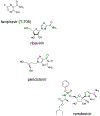Pharmacological approaches to the treatment of COVID-19 patients
- PMID: 33042589
- PMCID: PMC7543691
Pharmacological approaches to the treatment of COVID-19 patients
Abstract
The current COVID-19 pandemic has presented unprecedented challenges to the world community. No effective therapies or vaccines have yet been established. Upon the basis of homologies to similar coronaviruses, several potential drug targets have been identified and are the focus of both laboratory and clinical investigation. The rationale for several of these drug candidates is presented in this review. Emerging clinical data has revealed that severe COVID-19 disease is associated with heightened inflammatory responses and a procoagulant state, suggesting that patient treatment strategies must extend beyond antiviral agents. Effective approaches to the treatment of vulnerable patients with comorbidities will render COVID-19 substantially more manageable.
Keywords: COVID-19; SARS-CoV-2; antiviral; coagulation; coronavirus; inflammation.
Conflict of interest statement
Conflicts of interest The authors declare no conflicts of interest.
Figures





Similar articles
-
Pathogenesis-directed therapy of 2019 novel coronavirus disease.J Med Virol. 2021 Mar;93(3):1320-1342. doi: 10.1002/jmv.26610. Epub 2020 Nov 10. J Med Virol. 2021. PMID: 33073355 Review.
-
Human and novel coronavirus infections in children: a review.Paediatr Int Child Health. 2021 Feb;41(1):36-55. doi: 10.1080/20469047.2020.1781356. Epub 2020 Jun 25. Paediatr Int Child Health. 2021. PMID: 32584199 Review.
-
The British variant of the new coronavirus-19 (Sars-Cov-2) should not create a vaccine problem.J Biol Regul Homeost Agents. 2021 Jan-Feb;35(1):1-4. doi: 10.23812/21-3-E. J Biol Regul Homeost Agents. 2021. PMID: 33377359
-
An evidence-based systematic review on emerging therapeutic and preventive strategies to treat novel coronavirus (SARS-CoV-2) during an outbreak scenario.J Basic Clin Physiol Pharmacol. 2020 Sep 14;31(6). doi: 10.1515/jbcpp-2020-0113. J Basic Clin Physiol Pharmacol. 2020. PMID: 32924964
-
A review on the induction of host immunity by the current COVID-19 vaccines and a brief non-pharmaceutical intervention to mitigate the pandemic.Bull Natl Res Cent. 2022;46(1):31. doi: 10.1186/s42269-022-00719-x. Epub 2022 Feb 16. Bull Natl Res Cent. 2022. PMID: 35194369 Free PMC article. Review.
References
Grants and funding
LinkOut - more resources
Full Text Sources
Other Literature Sources
Miscellaneous
